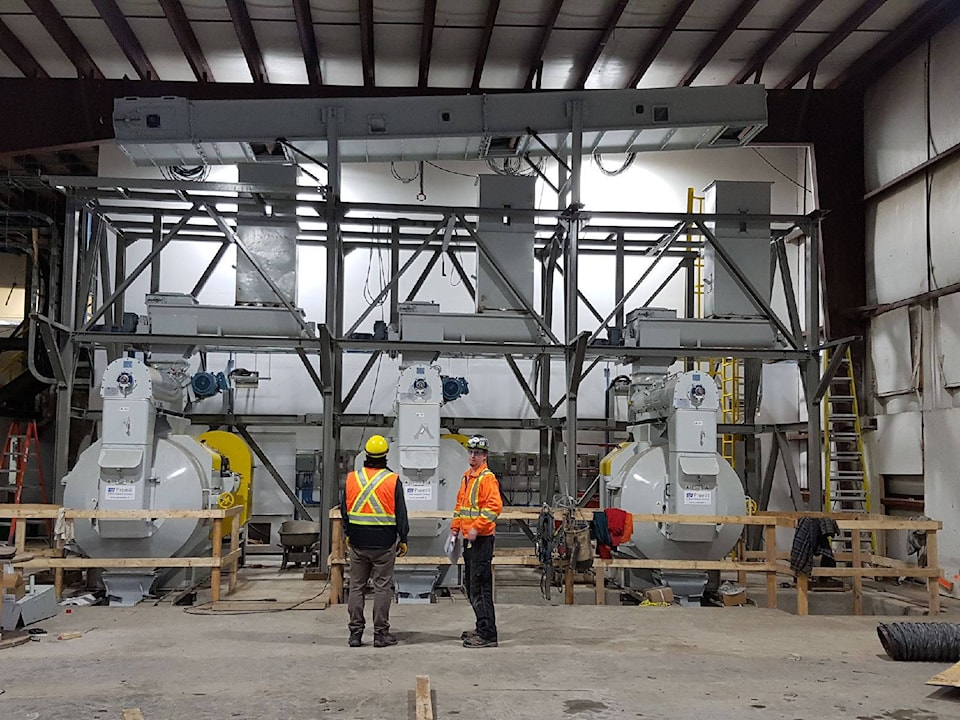Skeena Sawmills Ltd.’s $20 million pellet plant now has a way to export product from Terrace overseas, solidifying a new category of value-added wood products for the city.
The sawmill announced Feb. 1 subsidiary Skeena Bioenergy has entered a long term agreement with international supplier Pacific BioEnergy of Prince George to ship all of its production to Japan power producers via port facilities in Prince Rupert and Vancouver.
The plant is located adjacent to the Skeena Sawmills mill on Hwy 16 west of Terrace and is expected to start production in March 2019, producing around 75,000 tonnes of pellets per year.
The finished product will be contained in two silos and then deposited via telescopic chutes into waiting trucks or containers underneath for transport. The silos arrived on the plant this week as it enters the final stage of construction.
In addition to Japan, Skeena Bioenergy is also looking at tapping into other wood pellet markets including Europe, China and Korea.
“We’re already heavily engaged with the [Port of Prince Rupert] through our lumber business so we think there’s going to be opportunity to continue to utilize what we think is a competitive advantage with the Port of Prince Rupert, but also the markets that will be served through break-bulk shipments out of Vancouver,” says Skeena Sawmills sales and marketing vice president Rick Harris.
READ MORE: Pellets adding value to resource at Skeena
While the company could not confirm the value of the agreement, Harris says the partnership with Pacific BioEnergy will be a “profitable contributor to the business and to the region.”
Commenting on the agreement, president of PacBio John Stirling said in a press release, “This agreement with Skeena Sawmills contributes to our growing presence serving Japan’s demand for bioenergy products and advances our vision of bringing greater value to B.C.’s forest industry.”
The plant will progress to 24/7 operations in a phased manner, starting with single eight-hour shifts over five days before progressing to two eight hour shifts, then if successful, 24-hour a day operations for five days a week before the seven-day transition.
At full capacity, the plant is expected to create an additional 22 to 25 jobs.
Pacific BioEnergy has access to 100 per cent of the product produced at the pellet plant under its agreement with Skeena Sawmills, but Harris says there is flexibility to supply regional programs and business opportunities that arise in the future.
“Skeena’s pellet plant provides a critical outlet for residual fibre from the sawmill and builds on our commitment to maximizing value from the forest resource and generating local jobs from local logs in Northwestern British Columbia,” says Harris in a press release.
Between 75 to 80 per cent of the wood fibre will come from waste from the Skeena Sawmills, with 20 to 25 per cent from outside suppliers with opportunities to increase depending on supply.
Examples of possible sources include other sawmills within the region, wood waste from the Skeena Industrial Development Park or from land cleared for LNG Canada’s facility in Kitimat.
In the past, the sawmill would sell excess waste wood to other pellet producers including the Harmac pulp mill on Vancouver Island or loaded into the Kitsumkalum landfill. The sawmill has since been stockpiling its waste wood in anticipation of the pellet plant’s startup.
“Producing pellets from bark and sawdust (approx. 20 per cent of the log volume) makes this material a valuable product vs a waste,” wrote operations vice-president Roger Keery in an email to the Terrace Standard. “This improves the sawmill economics and supports the capital investment to modernize the sawmill.”
READ MORE: Skeena Sawmills spending millions to modernize
Turning a product that was formerly a line-item cost into a source of revenue will add value to the resource and allow the sawmills to increase their capacity from one shift to two shifts and afford measures to make their operations more efficient, Harris says.
So far, a new canter line which is used to break down lumber has been ordered, but upgrades to the sawmill will wait until the new pellet plant is up and running.
—with files from Jackie Lieuwen and Rod Link
brittany@terracestandard.com
Like us on Facebook and follow us on Twitter
